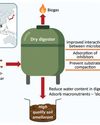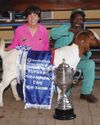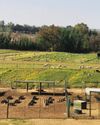Prøve GULL - Gratis
Is the 'second bite' really so bad?
Stockfarm
|November 2025
One of the most common misconceptions among grazing managers is that allowing animals to graze grass regrowth is harmful, says Richard Fynn, professor of Rangeland Science at the Okavango Research Institute, University of Botswana.

This approach suggests that animals should take only a single bite from each blade of grass before moving on. The belief is that a second bite will damage the grass and ultimately lead to veld degradation. Based on this view, animals should only return to a specific tuft after a long rest period.
Differences in grassland types
Speaking at the 2025 congress of the Grassland Society of Southern Africa, Prof Fynn said this perspective fails to account for differences in grassland types. “In arid regions, where grasses grow slowly and mature grasses retain much of their nutritional value, restricting animals from grazing regrowth has a limited impact on animal production. However, in mesic areas with annual rainfall exceeding 600mm, grasses grow more rapidly, and quality declines significantly as they mature. Forcing animals to feed only on long-rested, mature grass in these areas can harm production,” he explained.
Ultrahigh-density grazing
Linked to this misconception is the commonly held belief that ultrahigh-density (UHD) grazing – with very short grazing periods and extremely long rest periods – accurately mimics the natural behaviour of large wildlife herds. “In reality, herds move into areas with young, green grass, such as recently burnt patches, a few weeks after good rains. They graze the area down and move on, returning after several weeks when the grass has regrown to provide fresh, highly nutritious regrowth.”
Extensive evidence from studies (e.g. in the Serengeti and elsewhere in Southern Africa) shows that herds frequently return to the same area throughout the wet season. Research on buffalo in the Kruger National Park indicates that they revisit specific sites approximately every ten days. This differs from the holistic approach.
Denne historien er fra November 2025-utgaven av Stockfarm.
Abonner på Magzter GOLD for å få tilgang til tusenvis av kuraterte premiumhistorier og over 9000 magasiner og aviser.
Allerede abonnent? Logg på
FLERE HISTORIER FRA Stockfarm

Stockfarm
Boer goat management: Dosing for success
Boer goats were bred for South African conditions, making them hardy and well-adapted. However, like sheep, they still need to be dosed against parasites.
2 mins
November 2025
Stockfarm
Understanding the difference between inbreeding and linebreeding
The distinction between inbreeding and linebreeding is often confusing. A common misconception is that successful outcomes are attributed to linebreeding, whereas failures are blamed on inbreeding. Another inaccurate belief is that inbreeding refers to sibling matings (for example brother and sister), whereas linebreeding involves parent-offspring pairings. In reality, both scenarios are incorrect and should never be pursued intentionally due to its potentially serious genetic consequences.
2 mins
November 2025

Stockfarm
Dry anaerobic digestion: A sustainable, water-wise, waste-to-energy solution
Imagine an ideal world where cattle manure, crop waste and food scraps do not end up accumulating in landfills but are used to light up homes, cook meals, heat schools, and fertilise gardens.
4 mins
November 2025

Stockfarm
Is the 'second bite' really so bad?
One of the most common misconceptions among grazing managers is that allowing animals to graze grass regrowth is harmful, says Richard Fynn, professor of Rangeland Science at the Okavango Research Institute, University of Botswana.
4 mins
November 2025

Stockfarm
2025 Toyota SA National Young Auctioneer crowned
The winner of Plaas Media's Toyota SA National Young Auctioneer Competition was crowned on 12 September at NAMPO Cape in Bredasdorp. Five top aspiring auctioneers vied for the title, but it was Toog Vermaak who walked away with the honours. This marked the twelfth edition of the competition, with Toyota SA proudly serving as the name sponsor since its inception.
1 mins
November 2025
Stockfarm
Labour dynamics in South Africa's agricultural sector
Statistics South Africa's Labour Force Survey for the second quarter of 2025 released in August, estimates that around 16,8 million people were employed at that time. This represents an increase of approximately 0,9% (around 154 000 people) compared to last year. The unemployment rate is estimated at 33,2%, down 0,3% from a year earlier, but 0,3% higher than in the first quarter of 2025. Including discouraged job seekers, the broad unemployment rate stands at 42,9%.
5 mins
November 2025

Stockfarm
Boer goat management: Dosing for success
Boer goats were bred for South African conditions, making them hardy and well-adapted. However, like sheep, they still need to be dosed against parasites.
2 mins
November 2025
Stockfarm
Installation of electricity to improve farm dwellings
The Supreme Court of Appeal has upheld a Land Court ruling in Sibanyoni family vs Van der Merwe (the Sibanyoni case) namely that farm dwellers' right - as defined in the Extension of Security of Tenure Act, 1997 (Act 62 of 1997) (ESTA) – to improve their dwellings includes the right to have electricity installed.
2 mins
November 2025

Stockfarm
An integrated enterprise on a small piece of land
Hennie and Liza-Mari Jonker manage a highly productive 6,6ha farm outside Kroonstad, where they farm more than 800 sheep, 1 500 laying hens, two dozen Boer goats, and a flock of Damara sheep – all with the goal of living as self-sufficiently as possible.
5 mins
November 2025
Stockfarm
Importance of standardised testing in accurate genetic evaluation
In recent years, the beef breeding industry has witnessed a surge in private performance testing service providers catering to cattle breeders. This makes it more important than ever to emphasise the value of standardised performance testing procedures at testing centres. Such standards ensure that tests are scientifically sound, that the collected data is reliable, and that the results add value to breeders' selection decisions while benefiting the national beef industry.
2 mins
November 2025
Listen
Translate
Change font size

